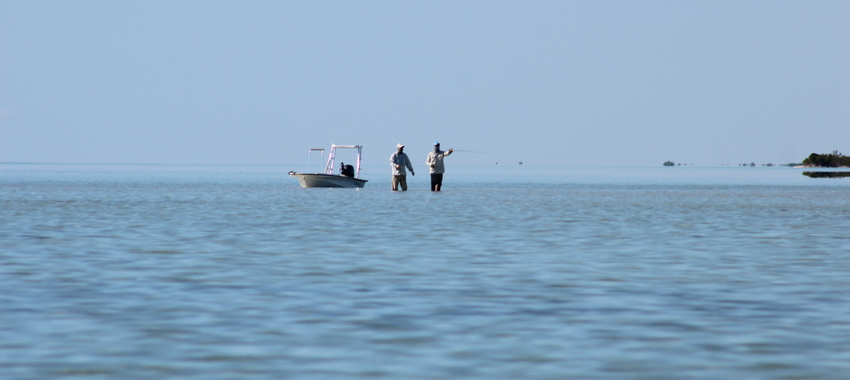A Cuba Super Slam!
March 6, 2019
At the end of January, I took my first ever trip to fish the pristine saltwater flats of the Cuba Zapata. Our group of 8 anglers had been fishing Ascension Bay MX together for nearly a decade, and decided we were ready to change things up. Going to the same place year after year is beneficial in many ways. Each visit allows you to build on your previous experiences and develop a more intimate understanding of the fishery, as well as a more meaningful friendship with the guides and staff members. We return each year better prepared with fishing gear and flies than the previous one, and eager to test new theories that we develop in the offseason. These factors translate into confidence, which helps us make the most of each special trip. This new trip to Cuba, however, reminded me just how exciting it can be to experience a new destination for the first time, too. The new set of challenges should not be a negative, as good pre trip planning will eliminate the anxiety of not feeling prepared. This allows you to focus on the excitement of what the new landscape will look like, what kind of fish you’ll encounter, and how the program will run. About 2 weeks before departure, I like to lay my gear and travel bags out on the dining room table to begin packing. This is when I tend to get the “shopping bug”. After all, a new experience deserves a new toy! For this trip, I decided to try a new 9 weight fly rod, and had just cast the Winston Air Salt a few weeks before and really liked it.
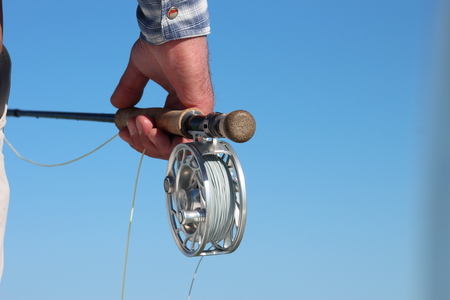
When I called our Winston rep to order it, he mentioned that he had just received his 10 weight Air Salt demo and suggested I bring that along to try, as well. I am one of those guys who would be hard pressed to pick a “favorite of all time” fly rod, but I lean towards the medium to soft action side of the spectrum with my casting style. Being a fly shop owner, I feel compelled to fish current gear to stay relevant in the retail market. That being said, when you cast a lot of rods, you find some that you like, and some that may not fit your particular casting style. I completed the Winston Air Salt 9 weight set up with a Hatch 7 Plus reel and Rio Flats Pro floating line. This would be my Permit rod for the week to go along with my Bonefish rod (G Loomis Asquith 8 weight), Tarpon/ Snook rod (Sage Bass II Largemouth), and Cuda rod (10 weight Winston Air Salt).
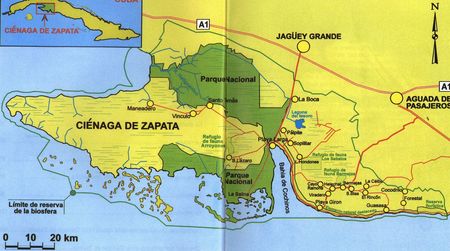
The first couple of days were mostly spent fishing the mangrove lined edges and shallow flats, throwing at whatever showed up. We had consistent action, catching numerous Tarpon, countless Bonefish, and a couple of great Barracuda. I only picked up the Permit rod a couple of times with fleeting opportunities. By day 3, I was committed to fishing for Permit and left the Bonefish rod in the rack. That morning was the windiest day yet, but the sky was blue, so visibility was good. The guide, Cachimbo, lined the skiff up along the deeper edge of the flat, and it wasn’t long before we spotted a push of water coming our way. As is often the case in windy conditions, fish pushing water show well because they are swimming into the wind so it creates waves moving in the opposite direction. If that same fish were to turn and swim with the waves, it would quickly become invisible. Unfortunately, when this situation presents itself, the angler is always dealing with a cross wind that can present a tricky angle for a cast. This shot was about a 60’er, and the fly landed perfectly, the fish turned and followed, and I expected an eat at any moment… then the fish just turned and vacated. We’ll never know what spooked that fish. Maybe I stripped too fast or too slow? Maybe he heard a wave echo on the boat gunnel? or Maybe he saw the leader….? Regardless, I put the fly where I thought that I wanted it and Cachimbo felt the same way, as he simply shrugged his shoulders and said, “good shot.” I know a lot of anglers would change their fly at that point feeling like the fish refused it; however, the fish was obviously interested, and I have a tremendous amount of confidence in that particular pattern (our custom tied Lagrow’s crab). A few hundred yards of poling later, another Permit showed behind another push of nervous water. The casting angle and distance were similar to the first shot. The fly landed and the fish ate on the second or third strip, and was off to the races! About 20 minutes later Cachimbo and I snapped a few photos and I released my first Permit in Cuba.
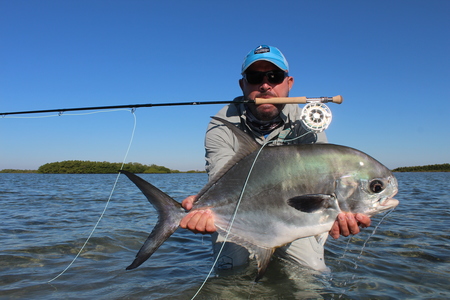
As we climbed back into the boat, Cachimbo picked up the rod to make sure the leader wasn’t nicked. “Very good cast” he nodded as he wiggled the rod tip. “Go ahead and cast it”, I replied. Like many flats guides around the world, he is a beautiful caster, and easily threw the entire fly line into the teeth of the wind. “Very nice,” he said and took a closer look at the label. Up to that point in the trip I had only cast the rod a few times myself, but I realized that was my sentiments too – very nice. Needless to say, I didn’t put that rod down the rest of the week. While I didn’t land any more Permit, I did have a few more shots, and the rod seemed to put the fly where I hoped it would go with each shot. I have to admit that on one shot, the fly landed, the fish swung in behind it, and as he was closing…. I missed a strip. I reached up to grab the line to repeat the looong, slooow strip cadence, and my fingers simply missed the line. I've seen lots of weird things happen in the pursuit of Permit, but to miss a strip of the line – with a nice Permit closing in on my favorite crab pattern with his mouth open... chalk that up to buck fever!
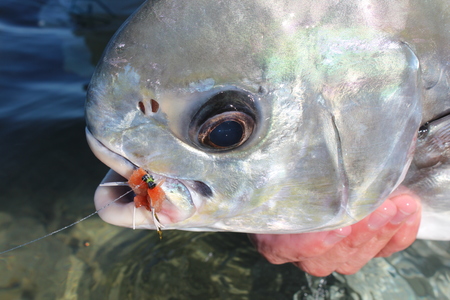
Anyone who chases Permit knows that it’s a high stakes game. There are so many things that have to go right in order to get your hand around the sharply forked black tail that we dream of seeing poking up on a shallow flat. It goes without saying that you need to have a rod in your hands that you “really like” when the opportunity to feed one presents itself. For me, the Winston 9 weight Air Salt fits that bill. While Winston describes this as a stiff rod, I believe that is a relative statement to their traditional Winston action. I found it to be a rod that you need to reach back with and wait… long enough to feel the flex dig deep on the back stroke before hauling it forward with a high release to finish the cast . With many of the ultra fast action rods, I find myself targeting a spot directly on the water and powering the cast forward and down on the front stroke. You may need to do this if the wind is an issue, but doing so can cause the fly to land hard and may spook fish. With the Air Salt, I found it pretty easy to elevate the aiming point and straighten the cast out 2’ above the water, dropping the fly softly on the spot. I think the G Loomis NRX 9 weight represents a sweet spot in that lineup, and casts similarly with a softer feel. I would describe the G Loomis Asquith and the Sage Salt HD as faster action options. This was the first trip I committed to using a 9 weight for my Permit rod, and I found it to be a beneficial upgrade for delivering crabs accurately in the variety of conditions we encounter on the flats. The 9 weight now has a permanent spot in my flats quiver!
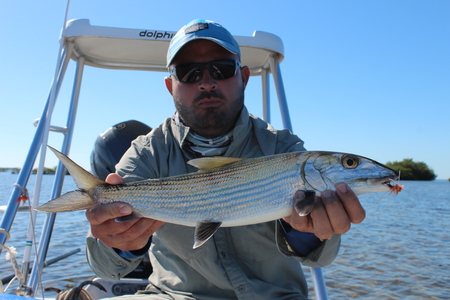
Now for the rest of the story… I have never been motivated get a Grand Slam (Tarpon, Bonefish, Permit on same day) or Super Slam (Tarpon, Bonefish, Snook, and Permit), mainly because I love fishing for Permit and if we get one, it’s likely that there could be more around. One other concern in pursuing a Slam is that you’re often sharing a boat with someone else and chasing fish to accommodate your desire may be a compromise to their day. The nice thing about the Cuba Zapata program, though, is that the daily fishing schedule allows each angler to fish half of the week as a solo angler in the skiff. Several anglers in our group were unsure that they wanted to fish alone before the trip, but after trying it for the first time, everyone really enjoyed it. Being on your own program for fishing, taking breaks, and getting every shot is a pretty unique and valuable component for a saltwater trip. That being said, after I landed the Permit that morning, Cachimbo suggested "Let's keep looking for Permit while the tides are good, then we get the Grand Slam this afternoon." He said it so confidently that it would have been hard to argue with him. Bonefish are plentiful on the flats and they’ll typically eat a Permit crab, so catching one as we continued poling for Permit was not difficult. Once the tide went out, we headed into the mangrove canals, which were too low to pole into so we got out and walked in mud that was often mid thigh deep. Cachimbo cracked a joke about crocodiles, which I didn’t find all that funny as we had just seen one not long before we got out of the boat to begin wading. The old Montana saying about not needing to outrun the bear – just needing to outrun your buddy went through my head more than once as we walked the edge!
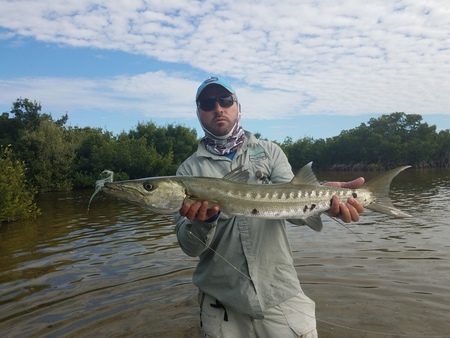
He carried the 10 weight with wire leader for Cuda, while I carried my Sage Bass II Largemouth rod (a 9 weight equivalent when you evaluate grains) with 40 pound bite tippet and a bait fish pattern. It wasn’t long before we spotted a nice Cuda laid up near the mangroves. Cachimbo and I traded rods, and I landed a big needlefish pattern about 3 feet in front of the fish. I don’t even know that I had a chance to strip the fly before the water erupted as the fish ate and simultaneously bolted for the open waters, porpoising as it ran well into the backing. Cuda are great fish to catch on the flats, and it was evident in Cuba that they haven’t seen a lot of pressure. Our group had a great Cuda week landing a dozen or more using streamer type flies and even poppers. We released that fish and continued the walk.
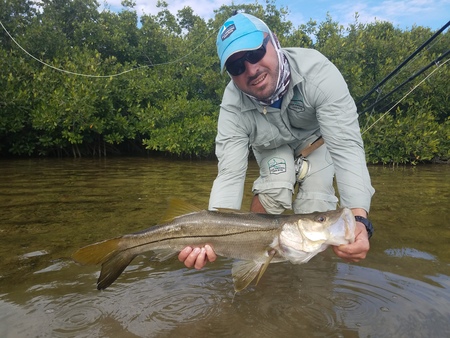
A little further on was an opening where a “creek” still yielding to the tidal pull was pouring into the open bay. We spotted another large Cuda positioned at the mouth lying in ambush. This would have been an amazing sequence to video, as the result was exactly the same as the previous shot just minutes before. The fly landed, the water erupted, and the Cuda was off to the races cartwheeling as it went… the difference is that as soon as this one vacated the creek mouth, both Cachimbo and I saw another big fish come out of the mangroves to occupy its’ exact spot. And this one happened to be a very nice Snook! With the Cuda now in the backing, Cachimbo and I switched rods again, and I proceeded to cast, strip, strip, strip, and set the hook on a nice Snook. So I had a Snook jumping and trying to escape back into the mangroves on one side, While Cachimbo had the feisty Cuda still running into open water on the other! We landed and released them both, shared a high five, and made our way back to the boat laughing and chattering about how crazy that whole sequence was.
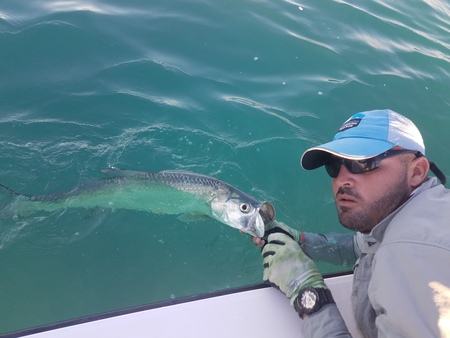
At that point, Cachimbo eagerly fired up the motor to head for a productive tarpon spot. He picked a red and black Pinocchio tarpon fly with a very strong hook and told me to change out my leader as we motored. I put a fresh 8’ section of 50 pound fluoro on and 20 minutes later Cachimbo cut the motor and began poling in deeper blue water in a wide lagoon between white sandy edges. “Got him,” he said as he picked up the poling pace to catch up with a group of tarpon that were rolling as they moved through the lagoon. As we got into casting range, Cachimbo coached “Fight him hard – don’t give him much line when he bites.” A solid 15-20 pound tarpon ate the fly after the second strip and I came tight fast with the rod tip low and tension high. The fish leapt and ran and leapt several more times. As we got him close he tried to go under the boat twice, which was easily dealt with by swinging the rod tip around and under the front bow to change sides. At 7’11” long, that Sage Bass II is a great rod for making tight casts in the mangroves, but also excellent for dealing with a fish like that going under the boat on a short tight line. We landed him, took a quick photo of the fish in the water, and let him swim. It was time to celebrate with a cold beer, and as I reached into the cooler, Cachimbo jumped up front. I thought we may be switching gas tanks, but instead he reached into the dry box and enthusiastically pulled out a flag which he tied to the front brace. That flag is the Grand Slam flag, and something the guides clearly take a lot of pride in raising for the return run to mothership Georgiana.
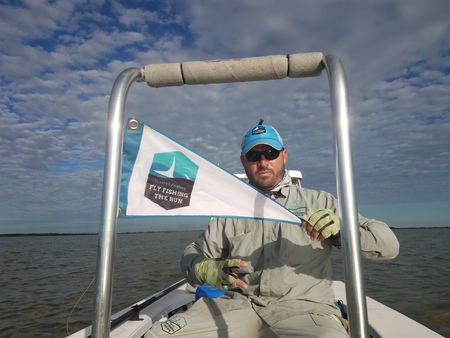
As it turns out, this was Cachimbo’s second ever Super Slam, and my first. This definitely ranks as one of my best days of saltwater fishing ever, and one that we'll be hard pressed to replicate. What I enjoyed about pursuing the Slam is that you experience the true diversity that fishing the flats can offer. That being said, I can't wait to return and try it again!
For additional information about fishing in Cuba, feel free to call or email Steve:
steve@redsflyshop.com
509-933-2300
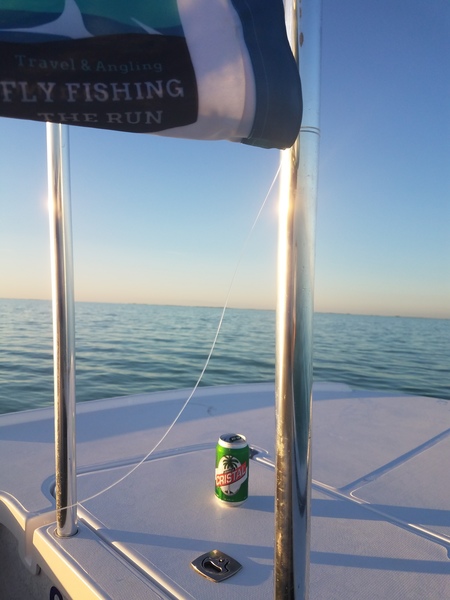
-
Keep typing. Great story.
-
Great read! Keep them coming
![Reds Fly Shop [logo]](/img/reds-fly-shop/logo.png)
